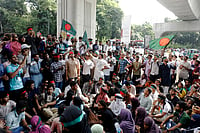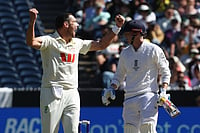Two Indians sit down to sip their cups of chai, they quickly agree that their country seems to be rising despite the state, and cynically express the idea of private success and public failure as: “India growing at night while the government sleeps”. But how could a nation become the world’s second fastest growing economy despite a weak, flailing state? And should not India also grow during the day? The recent slowdown is a sign that India may have begun to experience the limits of growing at night. Pondering over these burning questions, Gurcharan Das penned a new book, India Grows at Night. In this exclusive essay for Outlook, he makes a liberal case for a strong state.
The economic rise of India has been the defining event of my life. It is not only good news for its 1.2 billion people, but is also an instrument for good in the world. At a time when the western economies and their way of doing business is under a cloud, a large nation is rising in the East based on political and economic liberty, proving once again that open societies, free trade and multiplying connections to the global economy are pathways to lasting prosperity and national success.
Twenty-five years of high growth have made India one of the world’s fastest growing economies. Although the rate of growth has slowed recently from a scorching 9 per cent prior to the global financial crisis, the Indian economy is likely to continue to grow at between 7 and 8 per cent for the next couple of decades. This means that a large majority of Indians will soon emerge from a struggle against want into an age when they will be at ease. Poverty will not vanish, but the number of poor will come down to a manageable level, and importantly the politics of the country will also change.
A Baffling Story
The rise of their country baffles Indians. And for good reason: as this tale of two towns on the outskirts of Delhi—Gurgaon and Faridabad—illustrates. In 1980, Faridabad had an active municipality, fertile agriculture, a direct railway line to Delhi, a host of well-known industries, and a state determined to showcase it as Haryana’s future. Gurgaon, at the time, was a sleepy village, with rocky soil and pitiable agriculture. It had no local government, no railway link to speak of, and no industry. Compared to pampered Faridabad, deprived Gurgaon was wilderness.
Twenty-five years later, Gurgaon had become the symbol of a rising India and an engine of international growth. It had dozens of shiny skyscrapers, 26 shopping malls, seven golf courses, and countless luxury showrooms of global brands. It had 32 million square feet of commercial space and was home to the world’s largest corporations. Its racing economy was reflected in its fabled apartment complexes with swimming pools, spas and saunas, which vied with the best gated communities anywhere.
Faridabad remained sad and scraggly, groaning under a corrupt, self-important municipality. How did this happen? Gurgaon’s disadvantage had turned out to be an advantage. It was more or less ignored by the rapacious state government. This meant less red tape, fewer bureaucrats who could block its development. It flourished primarily because of its self-reliant citizens, who did not sit around and wait for the government. They dug bore wells to get water; they put in diesel generators to make up for the state electricity board’s failure; they employed security guards rather than depend on the police; since teachers and doctors did not show up at government schools and health centres, they opened cheap private schools and clinics, even in the slums, where fees were as low as Rs 200 per month.
Modern India is in some ways Gurgaon writ large. When Indians witnessed the stupendous rise of information technology and of cities like Gurgaon, they began to ask, “Why do we need a government at all, with corrupt politicians and unresponsive bureaucrats?” They said mockingly, “India grows at night when the government sleeps.” To rise without the state is a brave thing, but is it wise or sustainable? Gurgaon would be better off with a functioning drainage system, reliable water and electricity, good schools, roads and parks, and a decent public transport system.
Both Faridabad and Gurgaon are the wrong models of governance for India’s future. If red tape and corruption are the downside of Faridabad’s model, the problem with Gurgaon’s laissez-faire model is the lack of basic services. While India’s economic rise is a good thing and necessary for lifting the poor, it is not sufficient. We also need honest policemen, diligent officials, functioning schools and primary health centres. India needs a strong liberal state.
What Is A Strong Liberal State?
A successful liberal democracy has three elements, according to Francis Fukuyama in a sparkling new book, The Origins of Political Order. It has a strong authority to allow quick and decisive action; a transparent rule of law to ensure the action is legitimate; and it is accountable to the people. This was the original conception of the state as imagined by the classical liberal thinkers who inspired both America’s and India’s founding fathers.

Photograph by Manoj Kumar
Combining these three elements is not easy as they tend to place checks on each other, but in India we seem to have forgotten that the state was created to act. It should not take eight years to build a road when it takes just three elsewhere; it should not take the wronged 10 years to get justice instead of two. The rule of law in India has weakened as a result of populist and patronage politics. There is paralysis in executive decision-making, parliamentary gridlock and the courts routinely dictate action to the executive. An aggressive civil society and media have enhanced accountability in India, but enfeebled the executive.
India needs a strong, efficient and enabling state. Strong, because it has independent regulators who are tough on corruption and ensure that no one is above the law; efficient in the sense that it enforces—with fairness and forcefulness—the rule of law; and enabling, because it delivers services honestly to all citizens.
Confessions Of A Liberal Indian
I grew up in the idealistic days after Independence when we passionately believed in Jawaharlal Nehru’s dream of a modern and just India. We were mostly socialist then. As the years went by, we found that Nehru’s “mixed economy” was taking us to a dead end. Instead of socialism, we had ended with statism, and we sardonically called it the “licence raj”. For me, those four decades of missed opportunities were filled with personal humiliation. The reforms in 1991 finally brought an end to the agony.
As a result, I turned from a socialist to a libertarian, passionately committed to individual freedom. I began to believe that the state was “a second-order phenomenon”, at best a protector of what people choose to do in private life and at worst capable of destroying those freedoms. I felt a laissez-faire policy with a limited government would do the least harm to human beings. Now, two decades later, I have realised that I may have been wrong. I’m now convinced that the state is of first-order importance. It can either allow human beings to flourish or it can become the biggest obstacle to their realising their potential. A laissez-faire state, like a completely free market, has never existed and so the real issue is the extent and quality of government regulation. The state achieves this primarily by guaranteeing a predictable rules-based order. My conversion came about at the seeing the nation turning middle class alongside the most appalling governance. The final blow was the economic slowdown after 2010, when India finally hit a wall we began to experience the limits of “growing without the state”.
I have realised that I have come back to being a classical liberal, which means that I give priority to liberty over equality, unlike the “left liberals”, while I still fear state power.
Historically a Weak State
It is a mistake to think that the Indian state has weakened only in recent times because of coalition politics, weak leadership and economic liberalisation. India has historically had a weak state. But it has always had a strong society, and the average Indian has been defined by his place in that hierarchical society. It is quite unlike China, which has had a strong state and a weak society. Hence, India’s history is one of political disunity with constant struggles between kingdoms, unlike China’s history of strong empires. The type of despotic and intrusive governments that emerged in China, which divested people of their property and their rights, have never existed in India.

The king in Indian history was a distant figure and hardly touched the life of the ordinary person. The law, ‘dharma’, preceded the state and placed limits on the king’s power in pre-modern India. The king did not give the law as in China. Dharma was above the state, and the king was expected to uphold it for the benefit of the people. The king also did not interpret the law, unlike in China; the Brahmin interpreted the law. Hence, a liberal division of powers was created early and this may have contributed to a weak Indian state at birth. But it also prevented oppression by the state. Thus, the roots of liberty are far older on the subcontinent, going back to the restraints placed on the ruler by raj dharma, ‘dharma of the king’. Oppression in India came from society, especially from Brahmins. The classical Indian solution to this oppression was a spiritual entrepreneur, who broke away and created a new sect, the most famous perhaps being the Buddha.
Given this past, it is not surprising that after Independence, India went on to become an untidy democracy rather than a tidy autocratic state. And in the twenty-first century, true to character, India is rising from below, quite unlike China whose success has been scripted from above by an amazing technocratic state that has built extraordinary infrastructure. It is also not surprising that India’s traditionally strong society is evolving into a vibrant civil society. Anna Hazare’s movement in 2011 is only the most recent example of a historically weak state colliding with a strong society. A successful nation needs both a strong state and strong society to keep a check on each other.
What Is To Be Done
Anna Hazare’s movement has proven that crowds might awaken people, but they do not achieve the goal. Instead of chanting multitudes inspired by a mystical faith in the collective popular will, it will need the hard work of politics to transform India’s tottering state into a strong, liberal one. There is no magic bullet—such as a Lokpal—to achieve the goal. Instead, it will take patient, determined efforts to reform the key institutions of governance—the bureaucracy, judiciary, police and Parliament—along well-known lines articulated by numerous committees. The federal trend, which is shifting power away from the Centre to the states, is a virtuous one. So is the slow decentralising of power and funds downwards to achieve vigorous, local self-government in villages and municipalities.
Who will bell the cat? If it is lucky, India might throw up a strong leader who is a reformer of institutions (Indira Gandhi was such a strong leader, but she was a destroyer of institutions). Since there is no guarantee of a strong leader emerging in a democracy, the next best hope is to create a demand for reform. Since the demand for reform is unlikely to come from within the state, the answer lies with India’s society—with India’s newly awakened middle class. After a quarter of century of rapid growth, this class is now one-third of India; by 2022, it will cross 50 per cent. The nation’s centre of gravity is shifting and so will its politics. As Anna Hazare’s movement showed, this class will no longer accept a civic life shaped by those who are powerful and corrupt. It has also shown considerable ability to mobilise media and employ the new technology of social media. Politics are thus set to change.
Since India has historically had a weak state, strengthening it will not be easy. Even though the past matters, it does not mean that one is trapped in it. Time and again, India has shown the ability to change, often by borrowing new ideas and making them its own. History is not destiny, as they say. People in the end obey the law because they think it is fair and just, that it applies equally to all, and because they get morally habituated to it. It thus becomes a form of self-restraint. Eventually the habit becomes character. Hence, the demand for governance reform must emerge out of an Indian moral core. The notion of dharma imposed this moderation in pre-modern India and the question is if might help us to recover constitutional morality today.
Reforming corrupt government institutions is never easy. But it is a task that cannot be put off. India’s flailing state is not unlike the crisis-ridden Hastinapura in the Mahabharata. Just as we have a problem with our corrupt institutions of governance, the kingdom of the Bharatas had a problem with the self-destructive Kshatriya institutions of its time, and it had to wage a civil war at Kurukshetra to cleanse them. There are impatient voices in India today that are prepared to stage a Kurukshetra to bring accountability into public life. This was apparent in the clamour surrounding Anna Hazare’s movement. Although there is urgency to the task, it should be not be addressed through mobs on the street but through politics and institutional reform. Anna Hazare’s cautionary message is that if the political class is not up to enacting those reforms, then it better be prepared for a bloody civil war.


























